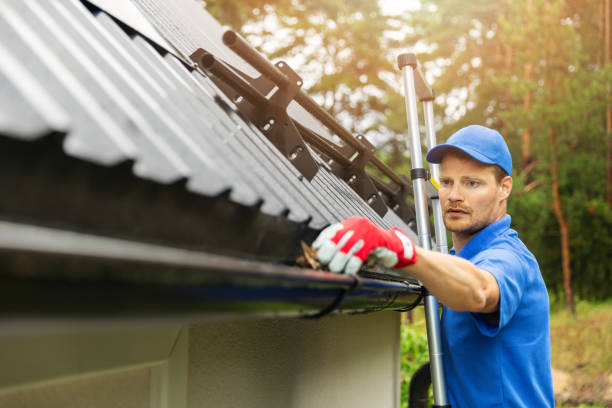How Proper Gutter Installation Protects More Than Just Your Foundation

You’ve probably heard that gutters help protect your home’s foundation. That’s true. But it’s also just the beginning.
Gutters are often one of the most overlooked exterior elements of a home. They’re not flashy, and they rarely make it onto renovation vision boards. Still, they play a crucial behind-the-scenes role in preserving your property’s value, comfort, and longevity.
When properly installed and maintained, gutters do far more than keep rainwater away from the base of your house. They protect walls, windows, roofing systems, landscaping, and even your home’s indoor air quality.
Let’s take a closer look at why these unassuming channels deserve more respect—and more attention—than they typically receive.
Redirecting Water: The First Line of Defense
At their most basic level, gutters manage one essential thing: water. When it rains, gutters collect runoff from your roof and channel it safely away from the structure.
Without a system in place, rainwater cascades down the siding, splashes onto soil, and pools around the base of the home. Over time, this leads to erosion, basement leaks, and compromised foundations.
But the story doesn’t stop there. Where water goes—or doesn’t go—impacts every layer of your home’s exterior and interior condition. That’s why experienced professionals, like the team at AG Exterior Solutions, place so much emphasis on getting installation right the first time.
Preventing Exterior Staining and Deterioration
Water that flows freely down exterior walls isn’t just inconvenient—it’s damaging.
Staining is often the first visible sign. Dark streaks or splotches near windows and doors may seem cosmetic, but they indicate a larger issue: water intrusion.
Over time, this kind of exposure weakens paint, warps siding, and causes wood trim to rot. Masonry can also suffer, as constant wetting and drying create cracks or surface decay.
By capturing and redirecting rain, well-placed gutters prevent this deterioration. They shield your home’s vertical surfaces and preserve its curb appeal—an investment that pays off when it’s time to sell or refinance.
Protecting the Roof’s Integrity
A lesser-known role of gutters is their impact on roof health. When water doesn’t flow properly off the roof, it can back up under shingles or pool in low spots, particularly near edges.
This creates conditions for mold, mildew, and rot—not only in the roofing material itself but also in the underlying structure. Ice dams can also form during winter months when water gets trapped and refreezes near the eaves.
Gutters, when properly pitched and cleared, prevent this type of buildup. They ensure that water exits the roof system quickly and cleanly, reducing the likelihood of both seasonal and year-round damage.
Poor roof drainage is an issue that often shows up only after it’s too late. Regular inspections and the guidance of professionals like AG Exterior Solutions can help spot early signs and make small corrections before they become major repairs.
Safeguarding Basements and Crawlspaces
One of the most costly consequences of neglected or improperly installed gutters is water infiltration at ground level.
When rainwater pools near the home’s foundation, it doesn’t just erode soil. It seeps down into basements and crawlspaces. Over time, this can lead to:
- Structural settling or cracking
- Mold growth in dark, damp spaces
- Pest infestation
- Indoor air quality issues
Even small amounts of moisture can cause big problems if left unchecked. That’s why the downspout is just as critical as the gutter itself. It must be positioned far enough away from the house to ensure that water moves out, not in.
Gutters and Landscaping: A Delicate Balance
If you’ve ever noticed trenches forming around your home after a storm, your gutters might be trying to tell you something.
Without proper control, rainwater can erode topsoil, drown plants, and wash away mulch or gravel. It’s not just a maintenance issue—it’s a design flaw.
Functional gutters work in harmony with your landscape. They channel water away from flower beds and turf areas, preventing runoff damage and protecting your investment in hardscaping and plantings.
In some cases, homeowners even install rain chains or rain gardens beneath downspouts to enhance water management in a visually appealing way.
Improving Home Comfort and Efficiency
Here’s a benefit few people associate with gutters: indoor comfort.
When your home’s envelope—roof, walls, and foundation—is properly protected from moisture, everything inside performs better. You get:
- More consistent indoor temperatures
- Fewer drafts and cold spots near walls
- Reduced humidity, which prevents condensation on windows
- Lower risk of allergens like mold and dust mites
It all ties back to moisture control. And moisture control often starts with the gutters.
Even HVAC systems run more efficiently when humidity levels are stable. So while gutters may not seem high-tech, their influence on your home’s comfort and energy use is surprisingly significant.
Durability Is in the Details
Not all gutters are created equal. Material, size, pitch, hangers, and seals all contribute to performance and lifespan.
Aluminum is popular for its rust resistance and affordability. Copper offers longevity and classic aesthetics but comes with a higher price tag. Steel is strong but must be coated to prevent corrosion.
Beyond materials, correct sizing ensures that your gutters can handle the volume of rain in your region. In high-precipitation areas, wider gutters or additional downspouts may be needed to manage heavy flow.
Improper pitch—too flat or too steep—can cause water to sit or overshoot the edges. Seamless systems reduce leak points, while well-anchored hangers ensure gutters stay in place during wind or ice.
It’s a nuanced process, which is why many homeowners rely on knowledgeable teams such as AG Exterior Solutions for both planning and installation.
Conclusion: Small System, Big Impact
Gutters aren’t glamorous, but they are powerful. They influence nearly every component of your home’s exterior and help guard against a cascade of issues—from foundation damage to roofing failure and indoor air quality concerns.
When properly installed, maintained, and matched to your home’s needs, they quietly do their job for decades, often without notice. But skip them—or cut corners—and you may find yourself dealing with preventable damage at every level.
If your gutters are outdated, sagging, or poorly draining, it might be time for an upgrade. Think of it not as an accessory, but as a critical part of your home’s defense system—one that deserves as much attention as any other structural component.
And while it may not top your renovation wish list, addressing your gutter system now could save you from far more expensive repairs down the road.
